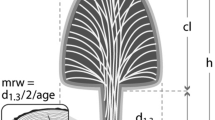Summary
To determine the effect of tree dimensions on the rate of height growth a model was constructed relating tree weight to total height and R, the ratio of crown weight to trunk weight. The model is based on the assumption that the trunk buckling safety factor is constant. If trees also maintain a constant R as they grow then the rate of height growth is maximized by R=0.17. In addition, the height growth rate increases as the buckling safety factor decreases. These predictions of optimal form for height growth are appropriate for shade intolerant, successional species growing in dense stands. Dimensional measurements of self thinning Populus tremuloides indicate near optimal dimensions for height growth. Trees ranging from 7 to 19 m in height had trunks which were only 50% thicker than the minimum required to prevent them from buckling under their own weight, and had a mean R of 0.13. This ratio of crown weight to trunk weight is significantly lower than the optimal value, but the predicted height growth rate for R=0.13 is 99% of that predicted for R=0.17.
Similar content being viewed by others
References
Beck DE, Della-Bianca L (1970) Yield of unthinned yellow-poplar. Southeast For Exp Sta USDA For Serv Res Paper SE-25
Brown RM, Gevorkiantz, SR (1934) Volume yield and stand tables for tree species in the Lake States. Univ. Minn Ag Exp Stn Tech Bull 39
Clark A, Schroeder JG (1977) Biomass of yellow-poplar in natural stands in western North Carolina. Southeast For Exp Stn USDA For Serv Res Paper SE-165
Ek AR (1974) Dimensional relationships of forest and open grown trees in Wisconsin. Univ Wis Forestry Res Note 181
Forbes RD (1955) Forestry Handbook. New York: Ronald Press
Givnish TJ, Vermeij GJ (1976) Sizes and shapes of liane leaves. Amer Natur 100: 743–778
Graham SA (1963) Aspens, Phoenix Trees of the Great Lakes Region. Ann Arbor: Univ of Michigan
Honda H, Fisher JB (1978) Tree branch angle: maximizing effective leaf area. Science 199: 888–890
Horn HS (1971) The Adaptive Geometry of Trees Princeton: Princeton University Press
King DA (1979) PhD thesis. Univ Wisconsin-Madison
King D, Loucks OL (1978) The theory of tree bole and branch form. Rad and Environm Biophys 15: 141–165
McMahon T (1973) Size and shape in biology. Science 179: 1201–1204
McMahon TA, Kronauer RE (1976) Tree structures: deducing the principle of mechanical design. J theor Biol 59: 443–466
Mohler CL, Marks PL, Sprugel DG (1978) Stand structure and allometry of trees during self thinning of pure stands. J Ecol 66: 599–614
Parkhurst DF, Loucks OL (1972) Optimal leaf size in relation to environment. J Ecol 60: 505–537
Taylor SE (1975) Optimal leaf form. In: DM Gates and RB Schmere (eds.) Perspectives of Biophysical Ecology. Springer: New York, p 73–86
US Forest Products Laboratory (1974) Wood Handbook: Wood as an Engineering Material. USDA Agri Handbook 72
Author information
Authors and Affiliations
Rights and permissions
About this article
Cite this article
King, D. Tree dimensions: Maximizing the rate of height growth in dense stands. Oecologia 51, 351–356 (1981). https://doi.org/10.1007/BF00540905
Received:
Issue Date:
DOI: https://doi.org/10.1007/BF00540905




